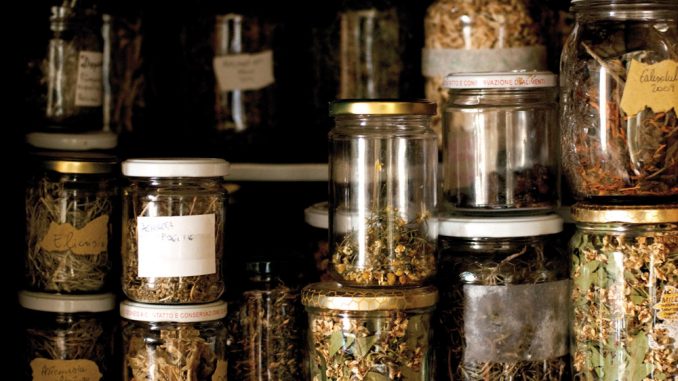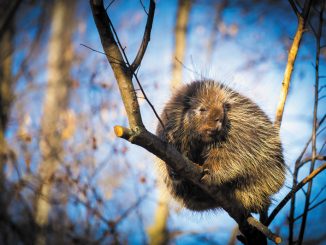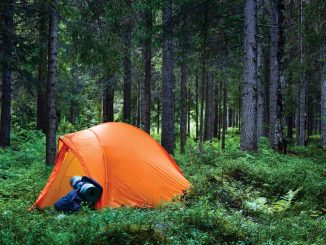
The weekend at a buddy’s mountain cabin sounded like a great idea, especially the 12-mile hike in from the dirt road … that is, until you got lost, never found the cabin or the dirt road where your truck is parked, and ran out of food. You’ve spent three nights in the dense underbrush of a Northwest forest, hopelessly lost, while the pangs of hunger are slowly consuming your empty stomach. Add to that, you’ve had a migraine since the third day out, not to mention the random bumps and bruises you’ve earned on the way.
… BY TAKING A PAGE FROM NATIVE AMERICANS, PIONEERS, BACKWOODSMEN, TRAPPERS AND MOUNTAIN MEN OF DAYS GONE BY, YOU WILL REALIZE THAT THE FOREST CAN PROVIDE MOST EVERYTHING YOU’LL NEED TO STAY ALIVE.
Lacking food, medicine and first aid supplies is a foolish mistake to make, especially when hiking alone in an unfamiliar place. However, by taking a page from Native Americans, pioneers, backwoodsmen, trappers and mountain men of days gone by, you will realize that the forest can provide most everything you’ll need to stay alive.

There are hundreds of plants that can help you, provided you know where to look and what to look for. Here is a selection that provides a variety of benefits and that you can find in widespread areas and grow on your own.
Cattail—Typha latifolia
Habitat: Wetlands, marshes, ponds, ditches, lakes
Where to find it: All over the world
Key characteristics: 1-inch-wide leaves with no central rib; leaves join tightly around the base. Grows up to 10 feet tall.
These tall grasses can be found throughout the world and are some of the most useful plants in the wild. In fact, Euell Gibbons, in his famous book, Stalking the Wild Asparagus, nicknamed this plant the “supermarket of the swamp,” because it is useful year-round.

The cattail is an ideal plant for preppers to be aware of because of its wide availability and multitude of uses.
Cattails are found in marshy areas and are easy to identify by their characteristic brown seed heads that resemble hot dogs. In the early spring, the plant’s roots can be eaten, and in the late spring and early summer, foragers can peel back the plant’s leaves to reveal the flower spikes, which can be eaten raw or cooked and have a taste similar to corn. The pollen of a cattail can be substituted for flour. In addition to providing a foraged feast, cattails also have several medicinal benefits. The viscous substance found between leaves makes a topical anesthetic, good for minor wounds and insect bites. A poultice made from the roots can sooth cuts, burns and stings. The leaves can also be woven into mats, baskets and shelters.
Yarrow—Achillea millefolium
Habitat: Disturbed dry soils, fields, meadows
Where to find it: Temperate areas of North America

Yarrow can be used to treat a variety of health issues, including colds, flu, headaches, diarrhea and stomach problems.
Key characteristics: Grows 3 feet tall. Leaves are alternate, 3 to 5 inches long. The flowers are arranged in large, compact clusters at the top of the stem; each cluster consists of 20 to 25 yellowish-white (and, rarely, pink) flowers. This flowering herb grows throughout North America and is typically found in fields and meadows. Yarrow’s leaves can be applied directly to bleeding wounds to stimulate clotting, and drinking a tea made from its flowers can be a remedy for a variety of ailments, including colds, flu, headaches, diarrhea and stomach issues. Yarrow can be used to break a fever by increasing perspiration and to treat rashes, such as from poison oak and poison ivy. Watch out, because this plant is very similar to water hemlock (Conium maculatum), one of the deadliest plants in North America. The big difference is that hemlock has a blotchy purple stem.
Mullein—Verbascum thapsus
Habitat: Along roads, fields, meadows
Where to find it: All over North America

Drinking tea made from mullein leaves can help coughs, sore throats, chest colds and bronchitis.
Key characteristics: Grows more than 6 feet in height, has large, hairy leaves and tall stalks of yellow flowers.
The entire mullein plant is covered in fine, downy hairs, and mullein’s big, soft leaves are a good substitute for toilet paper, which can be a godsend in a tough situation. Tea made from mullein leaves can be used to treat coughs, sore throats, chest colds and bronchitis. Although the tea from the leaves can be bitter, tea from the flowers is sweeter. Some Native Americans used mullein leaves to treat bruises, tumors and hemorrhoids, and a few drops of oil from the plant’s flowers (made by steeping the flowers in olive oil) can be used to relieve pain from earaches.
Rose Hips—Rosoideae rosa
Habitat: Well-drained meadows and prairies
Where to find it: All over the world

Rose hips are an excellent source of vitamins C, A and E and can be eaten raw or made into a jelly or syrup.
Key characteristics: Beautiful, ornamental flowers atop long stems bristling with thorns.
Rose hips are the seed pods of common, everyday roses. By leaving the dead flowers on the stems at the end of the season, small, berry-sized red seed balls will appear on them. These are rose hips and are quite edible (as are rose pedals). They can be found growing on various species of wild roses throughout the United States and will cling to the plant throughout the winter. These fruits are an excellent source of vitamins C, A and E and can be eaten as is or made into a jelly or syrup. Rose hips can be used for stomach disorders such as irritation and ulcers, but they are also good for treating diarrhea, constipation, gallstones, gallbladder ailments, lower urinary tract and general kidney pain.
Western Redcedar—Thuja plicata
Habitat: Moist to wet forested lowlands
Where to find it: Pacific Northwest

Western Redcedar has natural antifungal properties, and a tea made from its leaves can be used to soak feet afflicted with athlete’s foot or nail fungus.
Key characteristics: Averaging around 200 feet tall with massive trunks; the leaves are compressed and scaly and set close to the stem; the cones are small and only formed of up to a dozen large scales.
Known as the “tree of life,” the Western Redcedar is an evergreen whose bark is harvested in the springtime and used in a variety of ways. It can be used to make baskets, ropes, mats, blankets and clothing.
KNOWN AS THE “TREE OF LIFE,” THE WESTERN REDCEDAR IS AN EVERGREEN WHOSE BARK IS HARVESTED IN THE SPRINGTIME AND USED IN A VARIETY OF WAYS.
Redcedar bark makes amazing tinder bundles for starting fires. Even when it is raining, you can collect the bark and then scrape the inner part of it back and forth with a knife or stone so that it forms a fluffy bundle of fibers. The wood of the redcedar is also one of the best and most reliable woods for making friction fires using the bow-and-drill method.
Cedar has natural antifungal properties, and a tea made from its leaves can be used to soak feet afflicted with athlete’s foot or nail fungus. Cedar chips are also used to repel moths, ants and other insects.
Nettle—Urtica dioica
Habitat: Moist, deep soils; full sun
Where to find it: Grows easily almost anywhere

Tea made with nettles can be used to treat congestion, stomach ache and diarrhea, and a concentration of boiled nettle leaves can be used to clean infected wounds.
Key characteristics: Its largest characteristic is its tiny thorny needles, but it can grow up to 7 feet tall. The stems are covered in hairs that cause skin irritation, welting and reddening.
Various species of nettle grow throughout North America, and the younger plants can be eaten when lightly steamed or eaten raw. If the plant is taller (and in the springtime), only use the top couple of leaf clusters. Stinging nettle can be collected, dried and used as cordage, while decomposing nettle is a great fertilizer.
Boil the stems, leaves and roots to make a tea. Nettle tea can be used to treat congestion, stomach aches and diarrhea, and a concentration of boiled nettle leaves can be used to clean infected wounds.
Dogwood—Cornaceae cornus
Habitat: Dry to wet forests
Where to find it: Eastern United States (Cornus florida); northwestern United States (Cornus nuttallii)

The wood of a dogwood tree is dense and hard, making it a good choice for tool handles, walking sticks, arrows and other tools around camp.
Key characteristics: Flowering deciduous trees that can be identified by their “scaly” bark, pink or white flowers, and opposite leaves.
The wood of a dogwood tree is dense and hard, making it great for tool handles, walking sticks and arrows. The fruits of all dogwood species are “drupes” (meaning they have internal seeds like a peach or avocado) with one or two seeds and are often brightly colorful. Although they are edible and will provide some nutrition, many are without much flavor.
THERE ARE HUNDREDS OF PLANTS THAT CAN HELP YOU, PROVIDED YOU KNOW WHERE TO LOOK AND WHAT TO LOOK FOR.
A tea made from the bark and leaves of the tree can reduce fever and chills, and the tree’s branches can also be used as makeshift toothbrushes. Native Americans would chew on dogwood twigs to clean and whiten their teeth and massage their gums.
Wild Comfrey—Cynoglossum virginianum
Habitat: Open moist and cool uplands
Where to find it: Eastern United States and all of Canada

A tea made from the wild comfrey plant’s leaves can be applied to stings, insect bites, burns and wounds to relieve pain and fight infection.
Key characteristics: Alternating leaves covered with fine, rough hair. The flowers have rounded, light-blue petals that overlap each other.
Found in northeastern North America along streams, lakes and other bodies of water, wild comfrey is a coarse, hairy plant with pointed leaves and white or purple bell-shaped flowers. A poultice of its leaves can be used to treat wounds, and a tea made from the plant’s leaves can be applied to stings, insect bites, burns and wounds to relieve pain and fight infection.
Although the tea has been used traditionally to treat digestive disorders and respiratory infections (and it acts as a sedative), large doses or continued use can cause liver problems, because it may be carcinogenic.
Horsetail—Equisetum arvense
Habitat: Wet, sandy soil
Where to find it: North America

Horsetail tea can be used to ease stomach aches and treat kidney problems, and the plant can be used as a natural toothbrush in a pinch.
Key characteristics: Leafless stems grow directly from the ground.
Horsetail grows in areas close to rivers and streams throughout North America and can grow up to a foot tall. Look for bright-green, leafless, tubular stems that grow to a point (much like asparagus).
Chop and boil the plant and apply the paste to wounds to decrease bleeding and speed healing. You can also drink horsetail tea to ease stomach aches and treat kidney problems, and the plant can even be used as a natural toothbrush in a pinch. However, there are many who suggest that there are no medicinal effects from horsetail. In addition, it has been proven to be toxic to grazing animals.
Native Americans in the Pacific Northwest ate the young shoots of this plant raw, but it was used more to polish wooden tools. As well, the plants are used as a dye, providing a soft-green color.
Black Walnut—Juglans nigra
Habitat: Rich, deep, well-drained alluvial soils
KeyWHERE TO FIND IT: Eastern North America

In addition to eating the walnuts from the black walnut tree, you can chew the bark to ease toothaches.

Key characteristics: These deciduous trees can reach heights of 100 feet, have compound leaves and nuts that grow in singles or pairs.
Several species of walnut tree are found in North America, and they do much more than just provide a healthy snack. The bark can be used to make a black dye, while the wood is prized as being strong, durable and straight grained (great for making tools and furniture).
IT IS ALWAYS A GREAT IDEA TO KEEP YOUR CULINARY OPTIONS OPEN BY INCLUDING WILD PLANTS—EITHER EDIBLE OR MEDICINAL— IN YOUR GARDEN PLANS.
Obviously, you can eat the walnuts that grow from them (as many animals do), but the walnut leaves can be brewed to make a tea that treats constipation and diarrhea. The bark can be chewed to ease toothaches—however, pregnant women shouldn’t ingest anything made from walnut trees.
Red Huckleberry—Vaccinium parvifolium
Habitat: Moist, nutrient-rich environment
Where to find it: North America

Many native tribes of North America collected red huckleberries. They either ate them fresh or dried them to make into cakes for use later in the year.
Key characteristics: Bright-green branches and pink-red berries in early spring.
The red huckleberry’s delicate and translucent berries have been a source of food for generations of Northwest natives—animals and people alike. They are rich in vitamin C, available sugars and minerals such as manganese. Many native tribes of North America collected the berries and either ate them fresh or dried them to make into cakes with a tangy-tart flavor for use later in the year. They are easy to collect.
The dried leaves and stems, collected late in the summer to early fall, can be used in a tea to help with diarrhea and can be gargled to cure a sore throat or inflamed gums. Red huckleberries can be used as a vasoconstrictor, helping in restricting blood flow to heal wounds. However, it also raises blood pressure.
Burdock—Arctium minus
Habitat: Mild pastures and prairies
Where to find it: North America

Burdock helps digestion and can be used to treat gout, skin conditions such as eczema and psoriasis, and PMS bloating.
Key characteristics: Thin, bristly bulbs that flower into tightly packed pink/purple pedals at the top of a thin stalk. It can grow up to 5 feet tall and is bushy. Leaves are dark green above and fuzzy below.
Also known as burweed (because it tends to get tangled in the fleece of sheep), burdock is a biennial. Its unusually long taproot (up to 12 inches) can be eaten during its first year of growth in the fall, when nutrients are concentrated there. The rind of the flowering stalks must be removed before the stalks are eaten. Burdock’s leaves can be eaten before the plant begins to flower. You can add slices of burdock root to soups or stews, too. The flavor of burdock is earthy, sweet and slightly bitter.
Medicinally, burdock helps digestion and can treat gout, dry and irritated skin conditions such as eczema and psoriasis, and PMS bloating.
How to Grow Them Yourself
It is always a great idea to keep your culinary options open by including wild plants—either edible or medicinal—in your garden plans. Keeping a host of seeds of useful plants will mean that your survivor’s garden will be that much more helpful.
The amole (Chlorogalum pomeridianum) can make a great soap, while fireweed, dead bracken fern, dead grass, scraped cedar bark and inner bark from a dead cottonwood tree make excellent tinder.
Some wild plants, such as lavender and lemongrass, repel unwanted insects. Rosemary and thyme can be planted among lettuce, beans and peas to protect them from rabbits and deer.
Consider plants that grow easily—ones that gardening purists might call “weeds”—but also go outside your comfort zone by including plants not commonly found in yards like yours: prickly pear cactus, mesquite and agave (all edible). In addition, the yucca is a rich source of materials for survival needs, including fibers for cordage, edible flowers and young flowering stalks, soapy roots for hygiene needs, dry flower stalks for containers and fire-making materials.
There are many online sources that can provide a host of wild plant seeds for your garden or to merely sprinkle around your property and let Mother Nature propagate. Growing wild plants is easy and, in fact, will take very little effort from you besides choosing the plants that fit in your climate/environment.
Some seeds—such as milkweed, sweet-pepperbush and St. John’s wort, for example—can be planted in the early spring and fall, while others (such as bunchberry, wild plum and elderberry) need a cold period to germinate.
Editor’s note: A version of this article first appeared in the April, 2018 print issue of American Survival Guide.





Be the first to comment